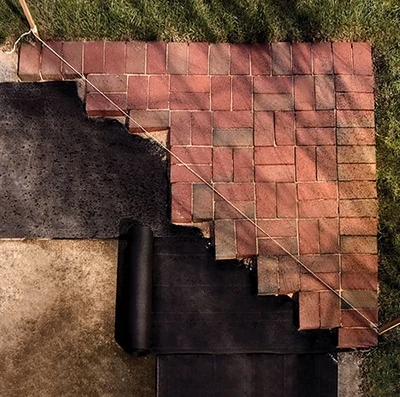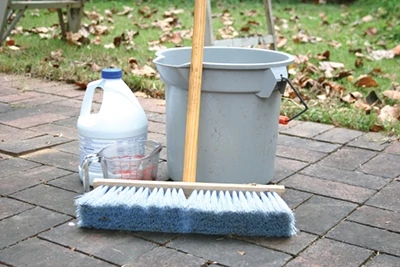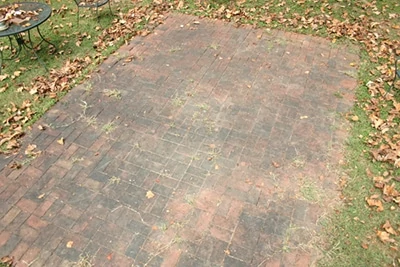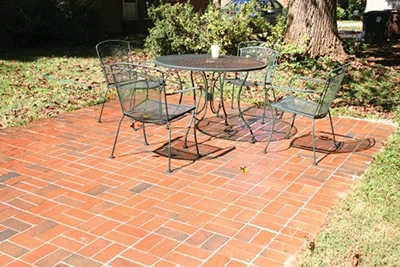By Walt Steele
There’s good news and there’s good news. You can have a new clay paver patio or walkway without digging, without spreading crusher run, without tamping, without measuring out an inch of sand and screeding it smooth. You can do it without cutting a single clay paver. And you can make it look brand-new 10, 20, or even 100 years from now.
Many patios and sidewalks are made of poured concrete. If you’d rather have something that doesn’t look so worn and dirty, and doesn’t need to be power-washed each spring, consider laying new clay brick pavers directly over the old surface.
“There are a number of advantages to doing it this way,” says Laura Schwind, a registered landscape architect for Pine Hall Brick Company, the largest supplier of clay pavers in the United States. “The biggest is that the base is already there, and you instantly improve the appearance of your property without having to dig up your old concrete and haul it away.”
With concrete that’s smooth and even, start by choosing the right type of clay paver. Keep in mind that there are “thinner” pavers (1-3/8 in.) for these applications. If there are exterior doors that must swing out over the new higher surface, that must also be taken into account.
Next up, choose your pattern. Some, like herringbone, require more cuts than other patterns. A basket-weave pattern requires no cuts at all, if you measure carefully.
To start, lay a “soldier course,” which means laying a line of bricks perpendicular to the edge of the concrete to form the outside frame of your project. The secret is to use four dots of masonry adhesive on each brick, each about the size of a penny, which allows rainwater to pass underneath.
On the inside of the soldier course, cut pieces of roofing felt to put a single layer inside the frame covering the concrete, and don’t overlap the felt edges. Then lay a second layer of felt perpendicular over the top of the first layer.
(Roofing felt? Yes. Roofing felt keeps the clay pavers from clacking against the surface of the concrete as you walk on the paver surface.)
Starting at one corner, lay the brick in place inside the “frame” that has been left by the soldier course. You’ll want to leave a 1/8-in. gap between the pavers for sand. Finish by sweeping concrete sand between the joints until they are full.
Here’s a peek at a project that used basketweave:
Taking care of it
The advantage to clay pavers is that they are the same color all the way through. While they are virtually maintenance-free, anything—clay pavers included—that’s left outdoors for years will need to be cleaned up once in a while.
And cleaning it up so it looks like it did the day it was installed is an excellent weekend project, especially if delegated to teenage children who want to use the car keys.
(This method works whether you have thin clay pavers or conventional ones installed above crusher run and sand).
This particular patio actually got its start decades ago. The former homeowner of this 1976 brick ranch house in Greensboro, NC had two daughters who wanted a playhouse. A concrete slab was poured in the backyard and a playhouse, complete with windows and doors and a shingle roof, was built atop it. As the two little girls grew up, the playhouse was moved to the back of the lot and converted into a small storage building. The slab remained where it was.
In 2006, the slab was covered with thin pavers. A basket-weave pattern was chosen because of its easy installation in which no brick cuts are required. A soldier course was glued in place with masonry cement along the edges of the slab, the roofing felt was rolled out onto the surface and the pavers were put into place. Sand was swept in between the pavers.
Over the years, the patio was regularly hosed down and weeds were removed in between the pavers. New sand was occasion-ally swept into the joints.
But this year was different. An unseasonably wet summer meant that grass grew quickly over the edges of the patio and into the sand joints between the pavers. Because the patio is shaded much of the day by tulip poplar trees, a greenish black fungus had grown over much of the patio surface.
To begin the cleanup, the leaves and other loose debris were blown off the patio with a leaf blower. A putty knife was used to cut the grass out of the paver joints and the surface was blown off a second time.
To clean the pavers, wet the surface thoroughly with a hose, then use a solution of one part of chlorine bleach to three parts of water. Pour it on the surface, allow it to stand for a few moments, then scrub it with a nylon bristle brush and a broom and hose it off.
It’s best to work on a small section at a time, so that the cleaning solution doesn’t dry on the pavers. Rinse it thoroughly and if needed, scrub it a second time. After the patio is cleaned, sweep fresh sand into the joints. Keep an eye on it, because in several weeks, you will probably want to sweep in more sand as the joints settle.
“It’s time and effort,” says Schwind on maintaining a paver patio. “But it’s worth it. When you’re done, you’ll have the beginnings of a new outdoor room where you’ll want to spend some time relaxing.”
Editor’s note: The author, Walt Steele, is a recognized expert on clay pavers. He is paver business manager for Pine Hall Brick Company, America’s largest manufacturer of genuine clay pavers. Visit www.pinehallbrick.com.








